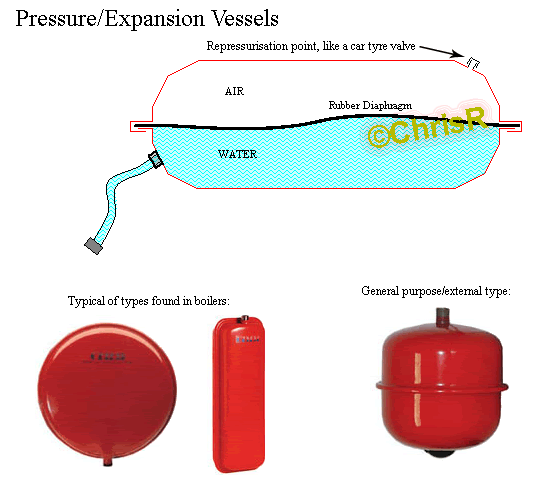1) REPRESSURISING THE PRESSURE VESSEL
NB, Pressure Vessel = Expansion Vessel.
Turn the boiler off at the mains.
Find the PV valve, which looks like a car tyre valve with just a threaded part sticking out. The PV is often red. They can usually be accessed from the top of the boiler or behind the front drop-panel. Some boilers such as Ravenheat can be impossible to access!
If water comes out when you press the central pin, you need a new PV
Find a drain cock. DO NOT use the pressure relief valve, or it'll leak afterwards.
Drain enough water from the system to drop the water pressure as read on the boiler gauge, to Zero. Close the drain cock.
Use any (eg car or bike) air pump to pump up the PV to eg 10 psi (0.7 bar).
Some boiler instructions might give slightly different figures. It isn't critical.
Remove and refit your pump to see how much the pressure drops when you remove it and inevitably lose some air.
If the pump doesn't have a built in gauge, pump it up a bit high, then keep taking readings with a push-on gauge. Every time you do, the pressure will drop a bit.
It's important that you don't rely on the reading as you pump into a "closed" system - as it starts to pressurise it'll give you a meaningless reading.
When you get to 10psi, undo your drain cock again. If there was still water in the PV, your air pressure will force it out. If that happens, recheck the pressure and pump more, and repeat until unding the drain cock doesn't give you a spurt of water. You can now rely on your air pressure reading.
The PV may be say 10 litres. If it was full of water you have to displace all of that water from the system side, by your pumping up the air in the vessel. That's a whole bucket of water!
Fill the boiler water back up to 1 bar pressure, slowly, and switch the boiler back on.
The air shouldn't be able to get into the radiator system because of the rubber diaphragm in the PV.
If you bleed your radiators, you will have to top up the water in the boiler via the filling loop, but not the air.
DO NOT let water into a hot boiler. Let it cool first.
DO NOT let water in too quickly. 20 seconds for 0.5 to 1 bar should be OK.
DO NOT take the water pressure above 1.5 bar- even if the system is warm as the switch may have stuck.
DO NOT allow the water pressure to go too high when refilling Turn it off early to see if the gauge keeps rising a bit.
NEVER use the Pressure Relief Valve to let water out of a system – it will leak afterwards!
If the pressure relief valve was leaking before you repressurised the PV, it will probably continue to do so and need replacing.

The expansion vessel diagrams shown here are incorrect. As shown it would not be possible to purge air from the water side of the diapragm when fitting a new one. (there is no "bleed valve" on the water side). The schrader valve is in fact connected essentialy to a rubber balloon which is deflated with xero air pressure and becomes inflated as the pressure is pumped up.
lukewarmbath


